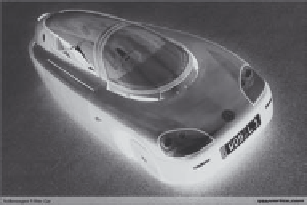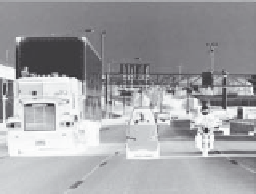Environmental Engineering Reference
In-Depth Information
This chapter will look at the hybrid powertrain configurations now in pro-
duction plus other hybrid propulsion system architectures. There may indeed be
other, more novel, hybrid propulsion architectures not covered here, but these are
likely to be developed for very specific mission profiles or niche markets or as
some variant of those discussed here. There are now also appearing concept vehi-
cles in a body style that is almost a motorcycle. These small, three and four
wheeled single or double occupant vehicles are meant to deliver very high fuel
economy numbers in the 100 mpg range. Daimler Chrysler, in their F-series of two-
seater sports cars, have introduced some very novel vehicle architectures [2]. The
F400 is a three wheeled sports car equipped with gull wing doors and front wheels
that use active camber control to lean into curves. The active camber tilts the
wheels out by as much as 20
during a turn in much the same way as a motorcycle
does. Referred to as a bubble car, the tandem seating vehicle performs and handles
more like a motorcycle than a passenger car. Volkswagen introduced an earlier
version of tandem seating, 2-passenger sports car, in 2001 called the VW Tandem
[3] (Figure 2.2). This vehicle is powered by a single cylinder CIDI engine with a
6.5 kW starter-alternator (S/A) that provides idle-stop and regenerative braking
functions. When VW first introduced their 3 L/100 km Polo vehicle in 1999, they
were the first to market such a highly fuel efficient passenger car. The Tandem,
powered by a 0.3 L, 6.3 kW at 4,000 rpm engine, delivers 1 L/100 km fuel con-
sumption and thereby sets a new benchmark in fuel efficiency. The Tandem is
registered for driving on public highways, and it was driven across Germany from
Tandem mass (kg)
267
Width (m)
1.25
Number of passengers (#)
2
Engine displacement (L)
0.30
Engine type
CIDI
Vehicle speed, WOT (mph)
70
Number of wheels
4
Aerodynamic drag (#)
0.159
Fuel consumption (L/100 km)
1
Fuel tank capacity (L)
6.5
(a)
(b)
(c)
Figure 2.2 VW Tandem 1 L/100 km concept vehicle: (a) VW Tandem,
(b) specification of tandem vehicle and (c) illustration of narrow
lane vehicles ( from Reference 4, with permission)











